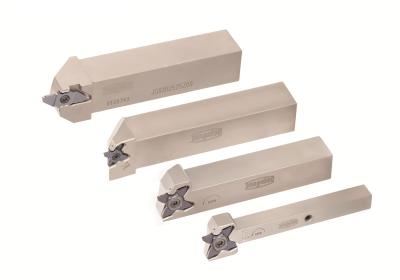
Tungaloy is expanding its DuoJust-Cut, TetraMini-Cut and TetraForce-Cut lines of indexable grooving and parting tools to enhance their flexibility and application ranges. Tungaloy’s DuoJust-Cut, TetraMini-Cut and TetraForce-Cut are successful lines of grooving and parting tool series that feature an innovative insert clamping interface for secure mounting during challenging operations.
DuoJust-Cut, a popular tool line among Swiss-style machine users, will now offer a 25 mm square shank holder to allow customers in the general lathe market to utilize its full benefits. In addition, new holders for TetraMini-Cut and TetraForce-Cut are available in 20 mm and 25 mm square shanks will be offered with Tungaloy’s high-pressure internal coolant capability to improve chip removal and tool life predictability.
A 12 mm square shank holder of TetraForce-Cut, designed to be compatible with Tungaloy’s DirectTung-Jet system, will also be released. This system enables interference-free tooling on designated Swiss machine models by channeling internal coolant directly from the tool post through the toolholder, with no need for an external coolant sub-assembly.
These new products will help customers seeking improved productivity and process security in various grooving and parting operations.
At a glance:
Enhanced lineup of highly robust toolholders for additional applications
New DuoJust-Cut holders ensure low force for deep grooving and parting-off
TetraMini-Cut’s new CHP-capable 2020 and 2525 square shank holders provide customers’ grooving operations with improved productivity
New TetraForce-Cut 1212 holder is compatable with DirectTung-Jet system for improved deep grooving and parting operations on Swiss machines; while its 2020 holder with CHP capability improve productivity in general turning applications
18 holders to be added in this expansion (metric 10 items, inch 8 items)
Contact Details
Related Glossary Terms
- coolant
coolant
Fluid that reduces temperature buildup at the tool/workpiece interface during machining. Normally takes the form of a liquid such as soluble or chemical mixtures (semisynthetic, synthetic) but can be pressurized air or other gas. Because of water’s ability to absorb great quantities of heat, it is widely used as a coolant and vehicle for various cutting compounds, with the water-to-compound ratio varying with the machining task. See cutting fluid; semisynthetic cutting fluid; soluble-oil cutting fluid; synthetic cutting fluid.
- grooving
grooving
Machining grooves and shallow channels. Example: grooving ball-bearing raceways. Typically performed by tools that are capable of light cuts at high feed rates. Imparts high-quality finish.
- lathe
lathe
Turning machine capable of sawing, milling, grinding, gear-cutting, drilling, reaming, boring, threading, facing, chamfering, grooving, knurling, spinning, parting, necking, taper-cutting, and cam- and eccentric-cutting, as well as step- and straight-turning. Comes in a variety of forms, ranging from manual to semiautomatic to fully automatic, with major types being engine lathes, turning and contouring lathes, turret lathes and numerical-control lathes. The engine lathe consists of a headstock and spindle, tailstock, bed, carriage (complete with apron) and cross slides. Features include gear- (speed) and feed-selector levers, toolpost, compound rest, lead screw and reversing lead screw, threading dial and rapid-traverse lever. Special lathe types include through-the-spindle, camshaft and crankshaft, brake drum and rotor, spinning and gun-barrel machines. Toolroom and bench lathes are used for precision work; the former for tool-and-die work and similar tasks, the latter for small workpieces (instruments, watches), normally without a power feed. Models are typically designated according to their “swing,” or the largest-diameter workpiece that can be rotated; bed length, or the distance between centers; and horsepower generated. See turning machine.
- parting
parting
When used in lathe or screw-machine operations, this process separates a completed part from chuck-held or collet-fed stock by means of a very narrow, flat-end cutting, or parting, tool.
- shank
shank
Main body of a tool; the portion of a drill or similar end-held tool that fits into a collet, chuck or similar mounting device.
- toolholder
toolholder
Secures a cutting tool during a machining operation. Basic types include block, cartridge, chuck, collet, fixed, modular, quick-change and rotating.
- turning
turning
Workpiece is held in a chuck, mounted on a face plate or secured between centers and rotated while a cutting tool, normally a single-point tool, is fed into it along its periphery or across its end or face. Takes the form of straight turning (cutting along the periphery of the workpiece); taper turning (creating a taper); step turning (turning different-size diameters on the same work); chamfering (beveling an edge or shoulder); facing (cutting on an end); turning threads (usually external but can be internal); roughing (high-volume metal removal); and finishing (final light cuts). Performed on lathes, turning centers, chucking machines, automatic screw machines and similar machines.







